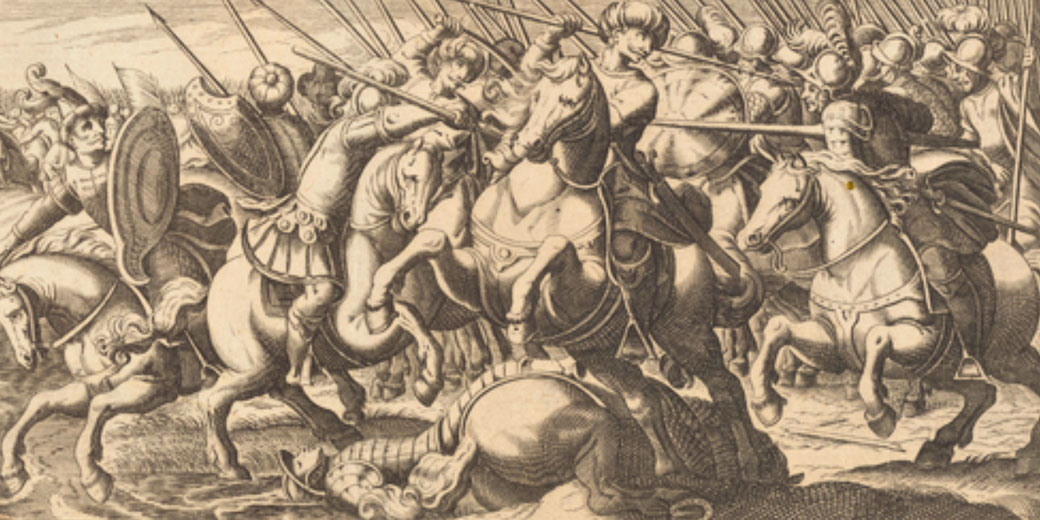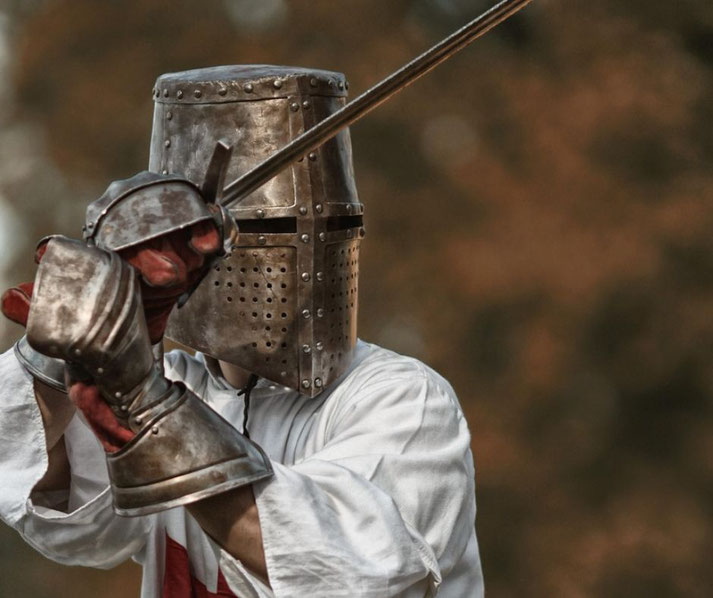The desperate battle for Ascalon: How the First Crusade nearly collapsed

Most people remember that the first Crusade ended with the successful capture of the ‘holy city’ of Jerusalem in July of 1099.
However, that did not mean that their fresh conquest was secure. In fact, it would be a second battle, at Ascalon a month afterwards, that would give the Crusaders the sense of confidence they needed to solidify their earlier success.
But it was almost a tragic defeat that could have easily undone everything the European leaders had fought for years to achieve.
Here is how it almost all fell apart...
The aftermath of Jerusalem’s fall in 1099
Crusader banners were quickly unfurled along the bloodstained walls of Jerusalem after the city had fallen on July 15, 1099, after a brutal siege that left thousands of its inhabitants dead.
Contemporary chroniclers describe streets choked with corpses, and the stench of slaughter in the air as victorious knights and foot soldiers looted homes, monasteries, and mosques.
Sadly, the survivors were forced to flee outside the walls or submit to their new rulers.
Their triumph had delivered the conquerors control of the Holy City, but their position remained uncertain.
The reality was that just a handful of war-weary warriors stood in command of a kingdom that lacked stability and sufficient reinforcements.
Their food and supplies were dwindling. What is more, many of the knights and footmen who had endured the march across Anatolia and Syria now considered their vows had been fulfilled and began preparations for their return to Europe.
Those who remained had to somehow establish order in a land still simmering with unrest.
To the south, a new threat loomed: the Fatimid vizier, al-Afdal Shahanshah, had dispatched an army from Egypt before the city had even fallen.
His troops marched north to reclaim what the Fatimids had lost. For decades, the rulers of Egypt had fought to control the Levant by defending their territories against both Turkish incursions and local uprisings.
However, their grasp on Palestine had weakened in recent years, but Jerusalem’s fall to Christian invaders was an intolerable humiliation and al-Afdal intended to drive the crusaders into the sea.
Back in Jerusalem, scouts brought reports of the Egyptian advance, warning that thousands of enemy soldiers had already crossed into their territory.
The crusaders knew that they could not afford to linger behind the walls of Jerusalem.
They knew that if the Fatimid army could manage to establish itself at the crucial city of Ascalon, which was the strongest fortress on the southern coast, any hope of defending the Holy Land would collapse.
The city’s strategic position made it a key stronghold, and the crusaders knew they had to act before their enemies fortified their position.
The Fatimid army gathers for war
Vizier al-Afdal Shahanshah understood that the loss of the Holy City threatened Fatimid control over Palestine and undermined Egyptian authority in the region.
In the months during the Crusader advance on the city, he had the foresight to order the recruitment of fresh troops, as well as gathering supplies in anticipation of a full-scale campaign.
Thankfully, he could rely on the resources of Egypt, thanks to its prosperous agriculture.
His first objective was to reach Ascalon quickly in order to establish a strong defensive position.
From there, he could launch a decisive strike to crush the crusaders before they could consolidate their rule.
The Fatimid army was reported to number around 20,000 men, which included well-trained cavalry and specialized archers.
Al-Afdal relied heavily on this professional cavalry, which were armed with long spears and curved swords.
Years of experience told him that they could charge enemy formations with devastating impact.
Most of his force was composed of infantry drawn from Egyptian garrisons and local levies.
However, among the most effective units in his army were Sudanese archers, who were known for their exceptional accuracy and the deadly power of their composite bows.
Unlike the Crusaders, the Fatimid forces had extensive experience in desert warfare and were accustomed to operating in the hot and arid conditions of the Levant.
From the outset, al-Afdal arranged for provisions to be transported along established trade routes between Egypt and Ascalon.
This would prevent food and water shortages that could weaken his forces before battle.
So, as his troops advanced along the coastal roads they were able to stay within close range of almost of the nearby supply centres.
In fact, the army was able to move faster than expected as a result of this and his approach coincided with the end of the brutal siege of Jerusalem.
He hoped that he could reach Ascalon before the crusaders could mount a response, which would give him the advantage of choosing the battlefield and dictating the terms of engagement.
The Crusader response
Determined to defend their hard-won conquest, the crusader leaders quickly organized a response to the Fatimid advance.
The de facto ruler of Jerusalem, Godfrey of Bouillon, recognized the urgency of the situation and called upon the remaining crusader princes to rally their forces.
Raymond IV of Toulouse, despite his ongoing disputes with Godfrey, understood the necessity of cooperation and brought his men to the campaign.
Likewise, Robert of Normandy, Robert of Flanders, and Tancred of Hauteville also answered the call.
The crusaders had already been fighting for years to reach the Holy Land, and their leaders knew that a single defeat could destroy everything they had gained.
Due to the heavy casualties sustained during the siege of Jerusalem, the crusader army remained significantly smaller than its Egyptian counterpart.
At most, they could field around 10,000 men, including no more than 1,200 knights.
These knights and their heavily armored warhorses, formed the backbone of the army.
When used correctly, they were capable of shattering enemy lines through concentrated charges.
The remaining forces consisted of foot soldiers, who were still learning how to adapt to the harsh conditions and the tactics of their Muslim opponents.
Since a number knights and their retinues had already departed for Europe, the crusaders could not afford a prolonged battle of attrition.
As a result, the crusader leaders devised a plan that played to their strengths. They believed that a direct attack on Ascalon, before the Fatimid army could fully entrench itself, was their best option.
To this end, they marched south as quickly as possible, covering the rugged terrain with minimal supplies.
When their scouts reported that the Fatimids had set up camp near Ascalon, rather than in the city, the crusader leaders decided on a pre-dawn assault, with its use of speed and surprise, could offset their numerical disadvantage.

What happened at the Battle of Ascalon on August 12, 1099
Before dawn on August 12, 1099, Godfrey of Bouillon, Raymond IV of Toulouse, and Robert of Normandy positioned their knights on the flattest ground their could find, with the infantrymen stretched between them.
Everyone was ordered to move quietly to prevent enemy scouts from alerting the Fatimid camp.
Once they reached the outskirts of the Fatimid encampment, the knights charged into the camp and cut down the disoriented warriors who were still waking up and who struggled to arm themselves.
Many tents collapsed as horses trampled through the rows of sleeping quarters. In the chaos, Fatimid officers scrambled to organize resistance.
In particular, the Sudanese archers attempted to regroup and fire volleys of arrows at the charging knights while the infantry units tried to form defensive lines.
The speed of the attack prevented them from holding their ground effectively and large gaps in the Fatimid formations allowed the crusaders to push deeper into the camp.
Eventually, the Fatimid soldiers began to regain their composure. Al-Afdal Shahanshah attempted to rally his forces and direct them toward the center of the battlefield.
Relatively quickly, his cavalry engaged the crusaders, but the fighting became extremely brutal, with knights locked in close combat against heavily armored Egyptian troops.
Meanwhile, the Fatimid infantry moved to hold key positions near supply wagons.
However, the crusaders, though outnumbered, maintained their momentum, and continuously broke through enemy lines as they formed.
The Fatimids suffered growing casualties as the battle dragged on.
As the sun climbed higher in the sky, the Fatimid army finally collapsed under the relentless pressure of the crusader offensive.
Al-Afdal ordered a retreat toward the coast. His men, now scattered and demoralized, abandoned weapons and armor as they fled toward their ships while the crusaders pursued the retreating enemy, cutting down stragglers and ensuring that no counterattack would follow.
By midday, the battlefield lay in ruins, littered with broken weapons, dead soldiers, and burning remnants of the Fatimid camp.
A decisive victory, but was it enough?
Defeated and humiliated, the Fatimid army retreated south, abandoning weapons, banners, and supplies as they fled toward Egypt.
Their forces had effectively collapsed in disorder. Al-Afdal Shahanshah himself barely escaped by sea and left thousands of his men dead or scattered across the countryside.
His failure to reclaim Jerusalem ended Fatimid ambitions in the region, which forced Egypt’s rulers to abandon further large-scale offensives for years to come.
As a consequence, the defeat at Ascalon weakened Fatimid influence in Palestine and left Egypt vulnerable to future crusader attacks.
What is more, the loss of so many experienced troops and valuable equipment strained Fatimid military resources.
This limited their ability to challenge the growing power of the crusader states.
Following their impressive victory, the crusaders had an opportunity to capture Ascalon itself.
However, internal disputes between the leaders prevented them from pressing their advantage.
Raymond IV of Toulouse argued for an immediate siege of Ascalon, believing that securing Ascalon would prevent further Egyptian invasions, but Godfrey of Bouillon, whose authority remained contested, hesitated to commit his forces without full support from the other crusader leaders.
The lack of unity among the princes prevented a coordinated effort. The Fatimid garrison inside Ascalon was able to use the brief pause to strengthen its defenses.
As a result, the city remained under Fatimid control, and it would provide a fortified base for future attacks against the Kingdom of Jerusalem.
This forced successive rulers of Jerusalem to maintain a permanent military presence in the south, which drained resources that could have been used for expansion or consolidation.
What do you need help with?
Download ready-to-use digital learning resources
Copyright © History Skills 2014-2025.
Contact via email
With the exception of links to external sites, some historical sources and extracts from specific publications, all content on this website is copyrighted by History Skills. This content may not be copied, republished or redistributed without written permission from the website creator. Please use the Contact page to obtain relevant permission.





